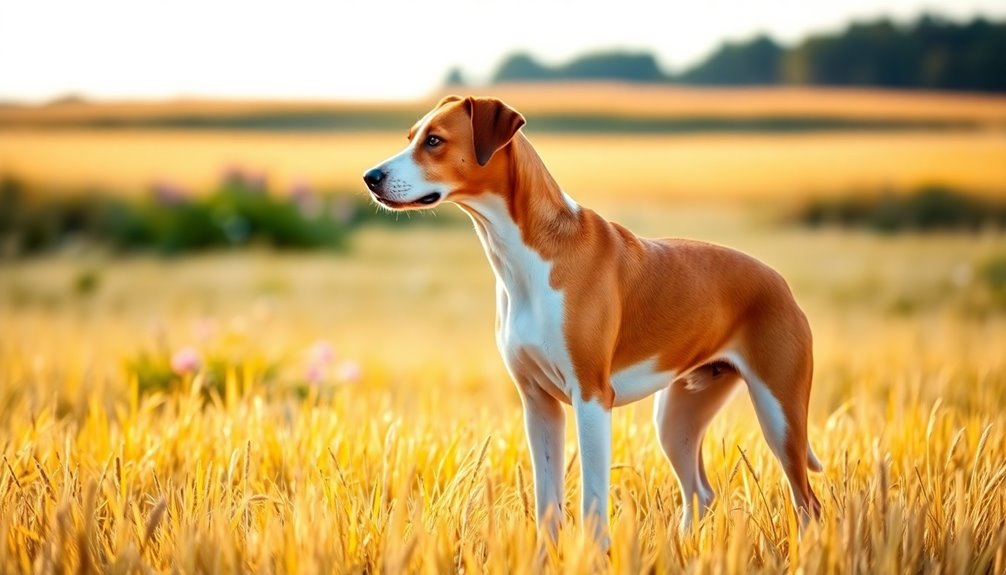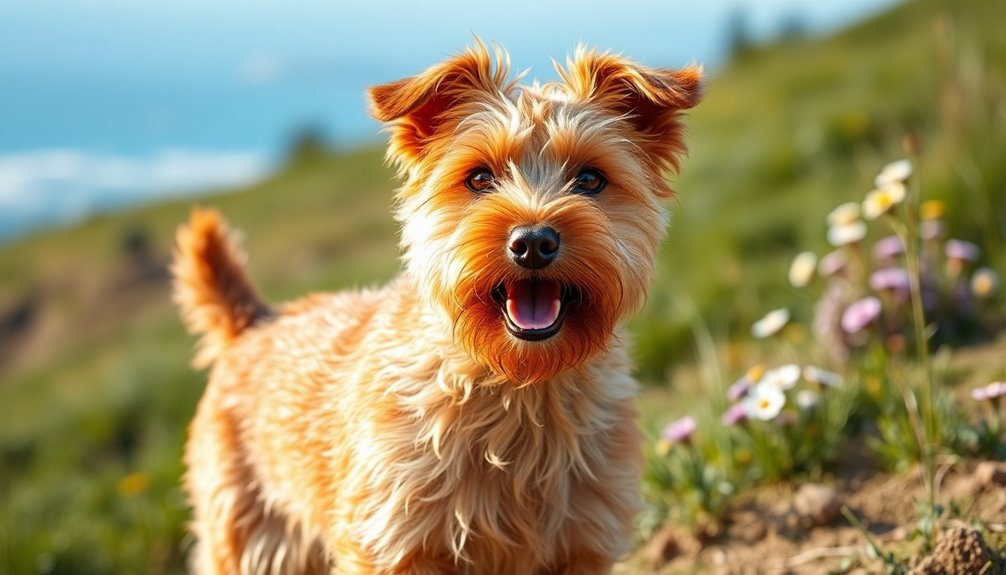If you're looking for the perfect hunting companion, consider the Brittany. With their athletic build and keen instincts, they excel in flushing and retrieving game. They stand about 18-20.5 inches tall and weigh between 30-40 pounds—ideal for energetic days in the field. Brittanys are friendly, eager-to-please, and thrive on vigorous exercise, needing at least 1.5 to 2 hours daily. Their adaptable nature makes them great in various hunting situations, while their playful temperament ensures they're enjoyable off the field too. Want to know what makes them even more exceptional? There's plenty more to discover about this remarkable breed.
Key Takeaways
- Brittanys are agile and compact, standing 18-20.5 inches tall, making them ideal for maneuvering in various hunting terrains.
- Bred for bird flushing and retrieving, they excel in adaptability and performance in field trials and hunting scenarios.
- Their playful temperament and eagerness to please make them highly trainable, essential for effective hunting partnerships.
- Regular exercise of 1.5 to 2 hours daily ensures they maintain peak physical condition and mental sharpness for hunting.
- Early socialization and training with birds prepare Brittanys for successful hunting experiences and improve their responsiveness in the field.
Introduction

When you're looking for the perfect hunting companion, the Brittany stands out as an exceptional choice. This breed's compact and athletic build, measuring 18-19 inches tall and weighing between 30-40 pounds, makes them agile and versatile hunters. Their dense, medium-length coat, available in shades like orange and white or liver and white, provides both protection and distinctive beauty.
Brittanys are known for their high intelligence and eagerness to please, which makes training them a rewarding experience. They thrive on regular exercise, needing at least 40 minutes daily to stay happy and healthy. If they don't get enough activity, you might notice restlessness or excessive barking. Additionally, their high energy means they require plenty of physical and mental stimulation to prevent boredom.
These dogs are friendly and social, cherishing interactions with their families. In the field, Brittanys excel at covering ground quickly, showcasing their skills in pointing, tracking, and retrieving game. Their versatility allows them to hunt various types of game efficiently, making them an ideal choice for avid hunters.
If you're ready for a committed companion that matches your active lifestyle, the Brittany could be the perfect fit for you.
History and Origin
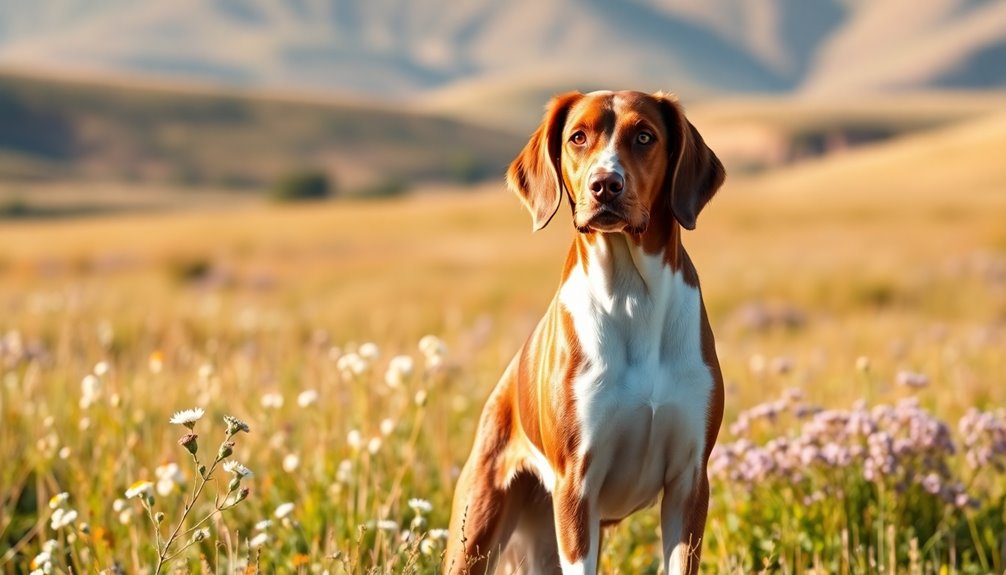
The Brittany breed originated in the rural region of Brittany, France, where it was developed before the 20th century.
Known for its exceptional bird flushing and retrieving abilities, this versatile dog quickly adapted to the local hunting conditions.
You'll find that its rich history is rooted in a blend of native spaniel-type dogs and imported English breeds, resulting in a unique and effective hunting companion. Additionally, multi-level lists can help organize information about different breeds and their characteristics, making it easier for enthusiasts to compare them.
Where and when the breed originated
Brittanys trace their origins to the rugged Bretagne region of France, where they were developed before 1900. This peninsula, located on the western coast, features a distinct cultural identity, with many locals speaking Breton, a Celtic language.
The challenging environment, characterized by cold, windy weather and rough vegetation, played a crucial role in shaping the breed. Local hunters sought dogs that could thrive in these tough conditions, leading to the breeding of versatile hunting companions. The use of run-in lists in documentation can enhance clarity and organization, ensuring that key points are easily referenced.
In the 1850s, English gentry visited Brittany for hunting, introducing their Pointers and Setters, which were left behind to mate with native dogs. This crossbreeding contributed to the breed's development.
The first recorded showing of a Brittany took place at the Paris exhibition in 1896, and it gained official recognition in France in 1907 with the establishment of the Club de L'Epagneul Breton. The breed standard was also drawn up that same year in Nantes.
Initially known as the Epagnuel Breton Queue Courte Naturelle, the Brittany would later make its mark internationally, with its first imports to Mexico in 1928 and the United States in 1933.
Bird Flushing and Retrieving
With their origins rooted in the rugged terrain of Brittany, these dogs were bred not just for their hunting prowess but also for their remarkable bird flushing and retrieving abilities.
While Brittanys aren't typically classified as flushing dogs, they possess a strong instinct to flush birds, especially in close cover where quick action is essential. Their versatility allows them to adapt to different hunting styles, making them effective in various situations.
Historically, medieval hunters prized Brittanys for their all-around capabilities. Originally called the Brittany Spaniel, they were later reclassified, reflecting their more pointing-like behavior. They have a distinguished presence in field trials globally, showcasing their skills and versatility in hunting.
They've been integral to French hunting traditions for centuries, excelling in shoot-to-retrieve trials that showcase their retrieving skills in both land and water environments.
Training is crucial for ensuring Brittanys stay within gun range and don't run birds out of control. With a strong foundation in obedience and various training methods, they can consistently retrieve birds, proving to be reliable companions in the field.
Their intelligence and high energy levels further enhance their performance, making them a perfect choice for those seeking a dedicated hunting partner.
Physical Characteristics
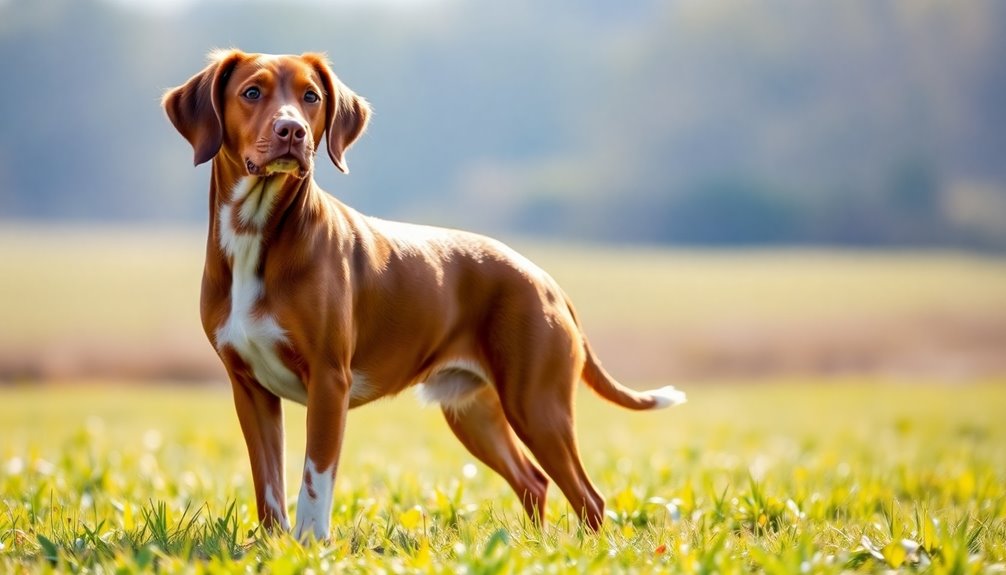
When you look at a Brittany, you notice their compact build and medium-length coat that comes in striking colors like orange and white or liver and white.
These dogs typically stand between 17.5 to 20.5 inches tall and weigh around 30 to 40 pounds, with a slightly smaller frame in females. Medium-sized dogs, Brittanys are smaller than setters but leggier than spaniels.
Their feathered legs and tails add to their distinctive appearance, making them both agile and attractive companions for any hunting adventure.
Size, weight, and coat details
A Brittany is a compact and agile breed, standing between 17.5 to 20.5 inches at the shoulder and weighing typically between 30 to 40 pounds. Some individuals can weigh up to 45 pounds, especially among American Brittanys, which tend to be larger than their French counterparts.
In the first three months, you'll notice rapid growth, with puppies reaching 13-18 pounds and around 12-14 inches in height. By 12-14 months, they achieve their full height, but muscle development continues until they're about 18-24 months old. This growth phase includes a significant increase in weight, with males typically weighing 30-40 lbs by 2-3 years.
Their coat features a spaniel-type texture, available in colors like orange and white, liver and white, and various roan patterns. You'll need to groom them regularly to keep their coat healthy and free of mats.
Weight management is crucial; you should be able to feel their ribs and see a defined waist. If not, they may be overweight. Conversely, underweight Brittanys show slower growth and may lack energy, so keep an eye on their body condition.
This breed's compact yet athletic build makes them ideal companions for hunting and outdoor activities.
Feathered Legs and Tail
The Brittany's physical appeal isn't just limited to its size and coat; the feathered legs and tail add to its distinct character. You'll notice feathering on both the front and rear legs, extending halfway to the hock on the thighs. Moderate feathering is preferred, as too little is better than too much. Regular grooming is essential to trim the feathering so it doesn't detract from your dog's movement.
When it comes to the tail, some Brittanys are born with a naturally docked tail or no tail at all. Traditionally, tails are docked to prevent burs from catching and to meet breed standards, typically measuring no more than four inches in length. The tail is set high, extending from the spine, and the long hair needs maintenance to prevent matting. Additionally, the tail length can influence the overall look of a dog breed, with Brittanys appearing more regal and distinguished when they have tails.
To keep the tail looking neat, trim the hair at the end and underneath, using scissors and thinning shears. Regular trimming not only enhances appearance but also promotes comfort and hygiene in the field.
Temperament and Personality
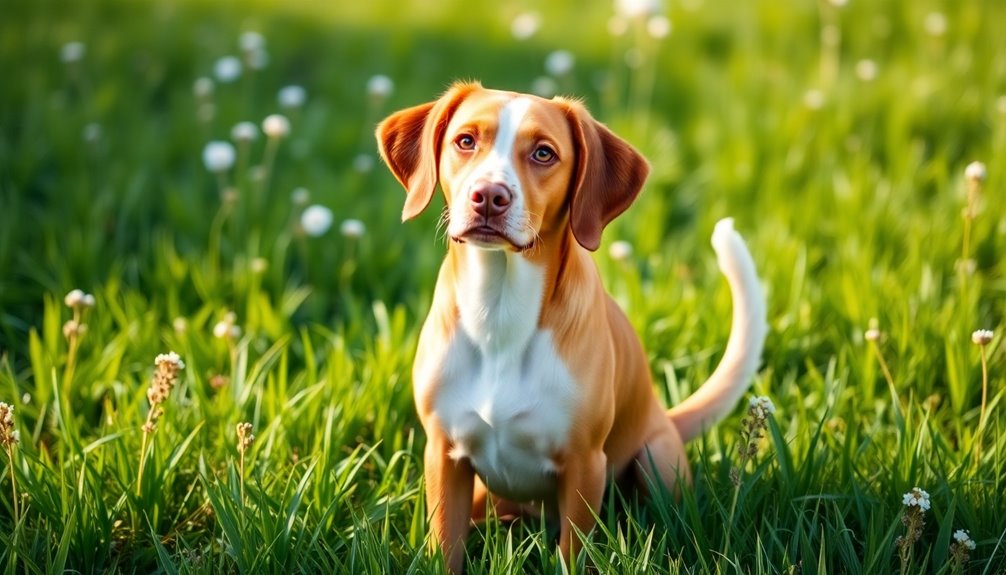
Brittanys are known for their playful nature and eagerness to please, making them fantastic companions for families and individuals alike. Their friendly demeanor allows them to get along well with other pets, creating a harmonious home environment. With the right training and socialization, you'll find that these dogs aren't only loving but also adaptable to various lifestyles. Their versatile hunting skills enable them to thrive in different activities, from family playtime to outdoor adventures.
Playful and Eager to Please
Joyful and eager to please, the Brittany embodies a friendly and affectionate nature that makes it a delightful companion.
You'll quickly notice its high energy levels, requiring at least an hour of vigorous exercise each day. Without adequate physical activity, your Brittany might become restless, barking excessively or roaming around. Engaging in activities like running, playing with kids, or joining you on hunts will keep your pup happy and fulfilled. This breed's daily exercise requirement of 40 minutes ensures they remain physically and mentally stimulated.
Training a Brittany is a rewarding experience, as they're highly intelligent and responsive to positive reinforcement. You'll find that gentle, calm commands work best; harsh words can make them timid or submissive. Starting early with socialization and obedience training is essential to help them thrive.
Suitability for families, individuals, or other pets
Affectionate and energetic, Brittanys make excellent companions for families, individuals, and even other pets. With their loving nature, they bond closely with family members, especially children, where they tend to be gentle and protective. However, their exuberance means supervision around young kids is essential.
They thrive in active households, requiring daily exercise—think fetch, running, or hiking—to channel their high energy constructively. For individuals, Brittanys are ideal if you can provide attention and regular activity. They suffer from separation anxiety, so a stable, engaging home is critical. Additionally, their high-energy nature necessitates at least 40 minutes of exercise daily to keep them physically fit and mentally stimulated. Proper socialization during their early months can greatly enhance their adaptability in various environments.
With at least 40 minutes of exercise daily, they need both physical activity and mental stimulation to prevent boredom and destructive behavior. Brittanys are also generally friendly with other pets. Their sociable nature allows them to coexist well with dogs and other animals, provided they receive proper socialization.
Early training is crucial to develop a calm temperament, making positive reinforcement techniques highly effective. Whether you're a family or an individual, Brittanys require commitment, patience, and a willingness to engage with them actively. With the right environment and care, they can become your perfect hunting companion and loyal friend.
Health and Lifespan

When considering a Brittany as your hunting companion, it's important to be aware of their typical lifespan, which ranges from 12 to 14 years. Like all breeds, they can face certain health concerns, including hip dysplasia and hypothyroidism, so regular check-ups and a balanced diet are essential. Additionally, responsible breeding practices can help mitigate the risk of common health issues.
Typical lifespan of the breed
Understanding the typical lifespan of a Brittany Spaniel is crucial for prospective owners seeking a long-term companion. Generally, these dogs live between 12 to 14 years, but with proper care, some may exceed this range. Various factors influence their lifespan, including genetics, nutrition, exercise, healthcare, and environment. Providing a balanced and nutritious diet is essential for maintaining your Brittany's overall health, which directly impacts longevity. Regular exercise and mental stimulation are also critical; an active Brittany is a happy Brittany. Additionally, their energetic and playful disposition contributes to their overall well-being and longevity. Don't forget routine veterinary check-ups, vaccinations, and preventive care, as these are vital to ensuring your dog stays healthy throughout its life. Creating a safe and engaging living environment will further enhance your Brittany's quality of life. Remember, the attention and care you provide can significantly affect their lifespan. Brittany Spaniels are generally a healthy breed, and with the right approach, they can lead long, fulfilling lives. They reach full adult size between 12 to 16 months, with middle age starting around 5 years and geriatric status beginning at about 10 years. Your commitment to their care is key to enjoying many years together.
Common health concerns or genetic predispositions
Brittany Spaniels, while generally healthy, can face several common health concerns and genetic predispositions that owners should be aware of. One major issue is hip dysplasia, which affects the stability of the hip joint, and elbow dysplasia, impacting the elbows.
Patellar luxation is another concern, causing the knee joint to slip out of place. Look for signs like weakness in the back legs, reluctance to exercise, and loose joints leading to osteoarthritis.
Eye health is also critical; Brittanys are prone to cataracts and other eye diseases, necessitating annual exams from ages 2 to 8. Early detection can prevent severe vision loss.
Neurological issues like epilepsy can occur, leading to seizures that require lifelong management. Hypothyroidism is another concern, resulting in lethargy and weight gain. Watch for symptoms like chronic infections and a dry coat. Additionally, regular veterinary check-ups are essential for maintaining overall health and identifying potential problems early.
Genetic factors, such as the bobtail gene, may affect tail length, while regular thyroid and heart checks are recommended to catch issues early.
Staying proactive about health monitoring can help ensure your Brittany remains a happy and active companion for years to come.
Tips for maintaining health and wellness
To ensure your Brittany Spaniel enjoys a long, healthy life, focus on a balanced approach to their care. Start with regular veterinary check-ups to monitor their health and catch any issues early.
Maintaining a healthy weight is crucial, so pay attention to their diet, ensuring it's balanced and appropriate for their energy levels. High levels of exercise are essential for this breed, so make sure their food intake matches their activity levels.
Given their high energy, provide daily exercise through walks, runs, or playtime. Activities like fetch or frisbee not only keep them fit but also stimulate their minds. Consider joining hunting trials or agility courses to engage their natural instincts.
Grooming plays a significant role in your Brittany's wellness. Regular brushing, especially during shedding seasons, prevents mats and keeps their coat healthy.
Don't forget to check their ears regularly to avoid infections and brush their teeth daily for optimal dental health.
Lastly, mental stimulation is key. Incorporate training sessions, puzzle toys, and family activities to prevent boredom and strengthen your bond.
Care Requirements
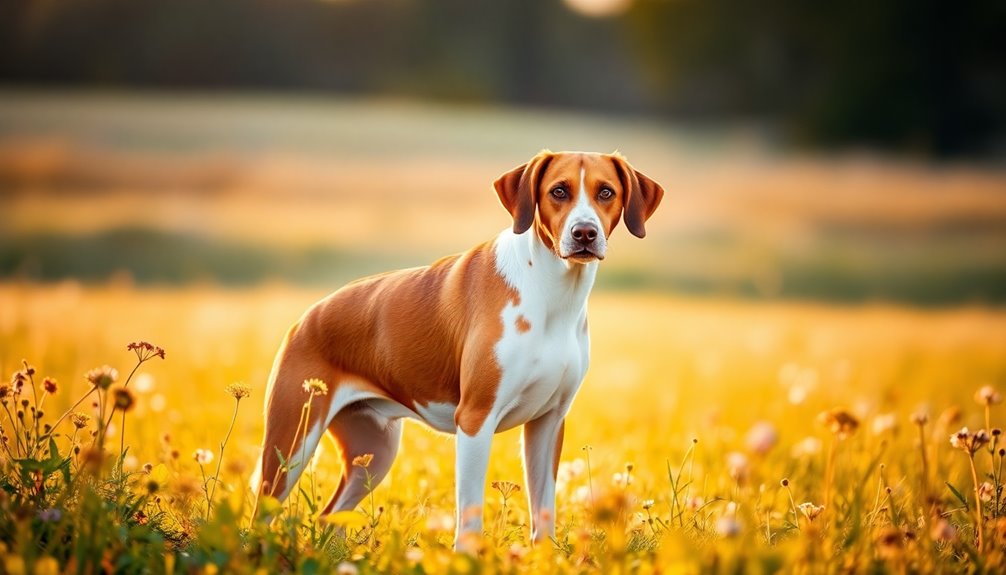
Caring for your Brittany means staying on top of their grooming, exercise, and diet needs. You'll need to brush their coat regularly, provide plenty of physical activity, and ensure they get a balanced diet to keep them healthy and happy. Additionally, it's important to note that Brittanys require 1.5 to 2 hours of exercise daily to thrive in an active environment.
Regular Brushing Required
Maintaining your Brittany's coat is essential for its overall health and appearance, and regular brushing makes a big difference. You should brush your Brittany about once a week using a soft brush or grooming glove. This routine helps control shedding, especially during the spring and fall when their coat tends to lose more hair. Additionally, a well-brushed coat can enhance the dog's overall comfort and well-being.
With a wavy, wash-and-wear coat, Brittanys require minimal grooming compared to other breeds, but that doesn't mean you can skip it entirely. If you want a sleeker look, consider trimming the coat around the neck, ears, and pasterns, though this is optional. Bullet point lists can be an effective way to outline specific grooming needs in a clear and concise manner.
Regular brushing not only keeps their coat healthy and shiny but also lets you check for any ticks, burrs, or cuts after outdoor adventures.
In addition to brushing, keep your Brittany's ears clean to prevent infections, brush their teeth daily for good dental hygiene, and trim their nails regularly. Occasional baths are necessary when they get dirty or smelly.
If your Brittany has a lot of white on its coat, using a dog coat whitening shampoo can help maintain its brightness.
Exercise requirements and energy levels
Brittanys thrive on daily exercise, requiring 1.5 to 2 hours of vigorous activity to keep their high energy levels in check. Engaging in brisk walks, jogging, fetch, or other high-energy activities is essential. If you don't meet these exercise needs, you might notice behavioral issues like barking, hyperactivity, and destructive chewing. Additionally, incorporating regular strength training exercises can promote overall fitness and well-being.
For puppies, start with about 5 minutes of exercise for each month of age, up to twice a day. Avoid high-impact activities, as their bones and joints are still developing. Always monitor their energy levels and adjust exercise accordingly.
Brittanys also benefit from mental stimulation, so consider interactive play, puzzle toys, or short training sessions. Including them in family activities can help prevent boredom and keep their minds sharp.
As your Brittany matures, they'll reach their full exercise capacity around 12 to 18 months. Continue monitoring their energy levels as adults, and engage in seasonal activities that align with their natural hunting instincts.
Providing a variety of activities will keep your Brittany engaged and help manage any potential behavioral issues.
Feeding tips and diet recommendations
When it comes to feeding your Brittany, establishing a consistent schedule is key to maintaining their health and energy levels. Feed your dog twice a day—once in the morning and once at night. For puppies, increase that to three or four times daily. Avoid free-feeding, as it can lead to weight gain; instead, stick to a structured feeding routine.
Opt for high-protein diets approved by AAFCO. Look for high-quality animal-based protein sources like beef, chicken, turkey, lamb, and eggs. Don't forget to include healthy fats, vitamins, minerals, and fiber from vegetables and berries. Tailor their diet to their life stage and energy needs for optimal health. Regular exercise is also important to complement their high energy levels.
Top brands like Purina, Royal Canin, and Hill's Science Diet provide quality options. If you're considering a raw diet, ensure it's well-balanced and consult a raw food calculator to determine the correct portions.
Always provide access to clean, fresh water, and monitor your Brittany's weight to maintain their ideal size. Regularly assess their diet to ensure it meets all nutritional requirements and avoid overfeeding to prevent any weight-related issues.
Training and Socialization

Training your Brittany requires consistency and patience, as they're highly trainable when you stick to a routine. Gradually introducing them to new environments helps build their confidence and reduces the risk of separation anxiety during training sessions. With the right approach, you can create a well-adjusted hunting companion ready for any challenge. Proper training can facilitate their natural instincts to point, enhancing their skills as a hunting partner.
Highly Trainable With Consistency
There's no doubt that a Brittany can be a highly trainable companion, especially when you apply consistent training and socialization methods.
Using techniques like the chaining method, you can teach your Brittany to stop on command with a whistle and associate that stop with pointing at a target. Practicing this from a distance will ensure your dog responds reliably.
The run and chase method introduces your Brittany to small animals, allowing them to learn to point naturally without catching their prey.
The "whoa" method further reinforces stopping on command, ensuring your dog understands "whoa" in any situation.
Establishing leadership through obedience and yard work is crucial. Use positive reinforcement—treats, toys, and praise—to build trust and loyalty. Consistency in commands will help your Brittany comply better. Basic obedience training plays a significant role in laying the groundwork for all future commands and hunting skills.
Daily exercise and mental stimulation are vital too. Engage your Brittany in activities like hunting or trail walking to keep them happy and healthy.
Socializing your dog with birds early in their training process prepares them for various hunting conditions. By maintaining consistency, you'll foster a well-trained hunting companion ready for any challenge.
Gradual Introductions to New Environments
Introducing your Brittany to new environments gradually is essential for building confidence and adaptability. Start by selecting quiet, distraction-free areas for initial training. Keep sessions short—about 5 to 10 minutes—and increase the duration as your dog becomes more comfortable.
Once your Brittany is confident, slowly introduce distractions, like parks or pet stores, to expose them to various sights and smells.
When socializing with people, invite friends over to meet your Brittany. This helps your dog experience positive interactions with different individuals. Use treats and praise to reinforce good behavior, and ensure introductions are calm and one at a time.
Supervise interactions with children closely to maintain comfort and safety.
For introductions to other animals, control the environment to prevent overwhelming your Brittany. Use a leash initially and keep the first interactions brief. Only allow off-leash play if you're confident your dog will respond to commands.
Neutral grounds work best for these introductions, ensuring both animals feel at ease. Gradually acclimatizing your Brittany to new situations helps reinforce their sense of safety, making future outings enjoyable for both of you.
Separation Anxiety During Training
Separation anxiety can be a significant challenge during your Brittany's training and socialization process. This behavioral disorder often manifests as excessive distress when you leave, leading to destructive behaviors, excessive barking, or even house soiling. Remember, this isn't a sign of disobedience; it's a genuine fear your dog feels.
To help your Brittany, establish a consistent routine. A daily schedule with regular feeding times, exercise, and play will provide security. Start by gradually increasing the time your dog spends alone, beginning with just a few minutes. Dogs thrive on structure, which can be beneficial in reducing anxiety.
Incorporate plenty of physical activity and mental stimulation, like interactive toys, to keep boredom at bay. Desensitization can also aid in reducing anxiety. Practice picking up your keys or putting on your coat without leaving, creating positive associations with these actions.
Over time, your dog will learn that your departures aren't a cause for stress. Additionally, consider crate training, as it can offer a safe space for your dog when alone. If the anxiety remains severe, don't hesitate to seek help from a professional trainer.
With patience and consistency, you can support your Brittany through this challenging phase.
Ideal Living Environment

If you're considering a Brittany as your hunting companion, creating an ideal living environment is key.
A house with a fenced yard gives your dog the space to roam safely, while their natural humidity tolerance means they can thrive in various climates. Additionally, their role as specialized pointing dogs makes them invaluable during hunting trips in the region. Moreover, ensuring their diet includes high-quality ingredients supports their overall health and energy levels during hunts.
Plus, their adaptability makes them perfect for both rural and suburban settings, ensuring they fit right into your lifestyle.
House With a Fenced Yard
A house with a fenced yard is the ideal living environment for a Brittany, offering both safety and freedom. The fenced yard reduces roaming, preventing your dog from wandering off or getting lost. It keeps them within a controlled area, minimizing risks from traffic or other animals.
Plus, it helps reinforce boundaries and training, reducing destructive behaviors caused by boredom. Implementing an in-ground fence can further enhance your dog's understanding of their limits and provide consistent corrections.
Your Brittany will love the freedom to explore and exercise within the secure space. This environment allows them to engage in natural behaviors like running and playing, supporting their mental and physical health. You can easily facilitate training and socialization without the worry of them escaping.
Owning a fenced yard simplifies daily care, providing a convenient area for potty breaks and exercise, especially during inclement weather. You won't need constant supervision or leashing, allowing your dog to relieve itself at its own pace.
Moreover, a fenced yard complements training methods, acting as a tool to reinforce boundaries and prevent unwanted behaviors. It helps maintain consistent training and supports your Brittany's high energy level, ensuring they get the necessary exercise they crave.
Humidity Tolerance and Adaptability
Humidity tolerance and adaptability are key factors in ensuring your Brittany thrives in various living environments. While they're not specifically cold-weather breeds, Brittanys can adapt to different climates with the right care.
In hot and humid conditions, providing good ventilation in their living space is crucial to prevent overheating. Ensure they've access to shade and fresh water, as these elements are vital for their well-being. It's also important to monitor their hydration levels, especially when engaging in regular exercise.
Conversely, during colder months, focus on insulating their dog house to keep them warm. A well-insulated structure with minimal drafts is essential, and using straw for bedding can help retain heat effectively.
Make sure to position the dog house in a location that shields it from harsh winds, possibly by installing a short wall panel or entryway to block drafts.
No matter the season, your Brittany's energy level remains consistent, so regular exercise year-round is important.
Distinctive Orange and White Coat
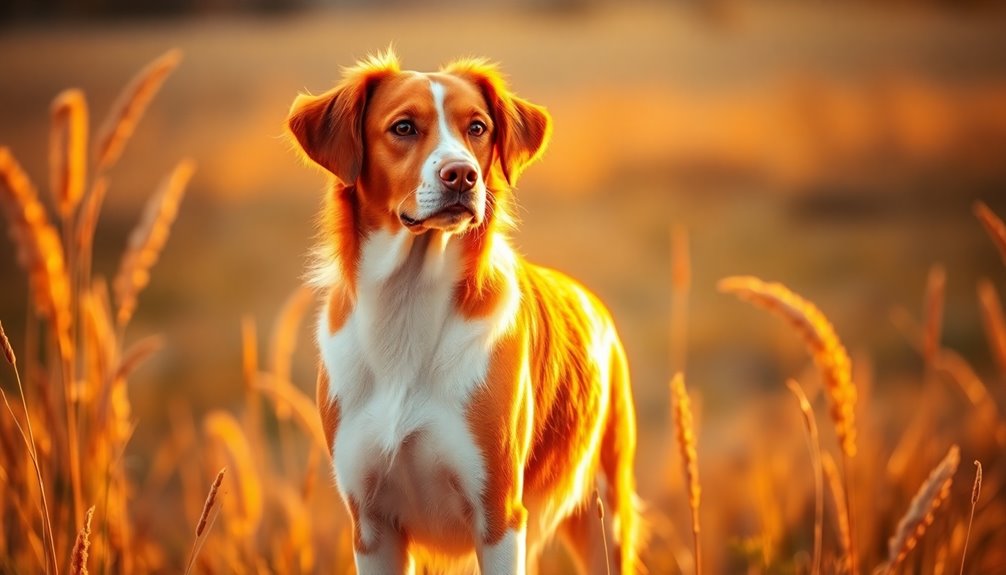
The Brittany's distinctive orange and white coat isn't just eye-catching; it also plays a vital role in various hunting scenarios.
This striking coloration has made them famous in bird hunting lore, allowing them to stand out in the field while blending into natural surroundings. Their unique coat colors contribute to their appeal and functionality as hunting dogs.
When you're out hunting, this unique coat helps ensure your Brittany is both a reliable companion and a standout performer.
Versatile in Various Hunting Roles
Brittany Spaniels stand out not just for their impressive hunting abilities but also for their striking orange and white coats. Their versatility makes them ideal companions in various hunting roles. As primarily pointing dogs, they excel at locating game birds and holding a point, allowing you to approach and flush the birds effectively. This instinct to point rather than flush reflects their genetic lineage, making them invaluable for upland bird hunting.
While they shine in pointing, Brittany Spaniels can also flush game birds from thick cover. Their agility and speed enable them to navigate different terrains, from dense brush to open fields. These dogs are known for their natural instincts for hunting and retrieving game, which further enhances their effectiveness during hunts.
Once the hunt is successful, their excellent retrieving skills come into play, whether on land or in water. Their water-resistant coat and natural affinity for water make them adept at retrieving downed birds.
These dogs adapt well to various hunting styles, tracking, and obedience tasks, ensuring they can handle the demands of the hunt. With their medium size and energetic nature, Brittany Spaniels are reliable partners who thrive on regular exercise and positive training, enhancing both your hunting experience and your bond with them.
Famous in Bird Hunting Lore
While their hunting prowess is impressive, Brittany Spaniels are also celebrated for their distinctive orange and white coats, which make them easily recognizable in the field. This breed features a single coat that's medium-length and dense, with textures that can be either flat or wavy. Unlike some breeds, they don't have wiry, silky, or curly coats, simplifying your grooming routine.
You'll find that the primary colors are orange and white, but they can also come in liver and white combinations. Some Brittanys exhibit a roan pattern, while tri-colored variations exist, though black isn't recognized by the American Kennel Club. The coat colors are more than just aesthetic; they're a key identifying feature of the breed. Additionally, the coat provides insulation and protection in various weather conditions, making them versatile hunting companions.
Grooming needs are moderate, requiring weekly brushing to remove excess hair and dirt. They shed year-round, with heavier shedding during the warmer months. However, maintaining their coat is relatively easy compared to double-coated breeds, helping you prevent matting and tangling. With their stunning appearance and remarkable abilities, Brittany Spaniels truly hold a special place in bird hunting lore.
Active Lifestyle Compatibility

If you lead an active lifestyle, a Brittany is the perfect companion for you.
They need at least 1.5 hours of exercise daily and thrive on activities that challenge their energy and intelligence. Incorporating a balanced diet rich in omega-3 fatty acids can further support their health and energy levels.
With their friendly nature and love for family, they'll keep you motivated and engaged in fun outdoor adventures. Additionally, participating in field trials can provide structured activities that further enhance their skills and bond with you.
Ideal for Active Lifestyles
For those who lead an active lifestyle, a Brittany makes an ideal companion, as these dogs thrive on energy and engagement. You'll find that they require a fenced yard or plenty of open land to run and play, making them less suited for apartment living. In homes with large yards or acreage, they flourish and stay happy, avoiding boredom and destructive behavior.
Brittanys are great with families, especially those with children who enjoy roughhousing. They're generally good with other pets when socialized properly, and they love interacting with visitors. Just keep in mind that their rambunctious nature may require supervision around younger kids.
If you're someone who enjoys outdoor activities like hiking or running, a Brittany can easily adapt. They excel in competitive events year-round, but they do need owners who can dedicate time to training and socialization. To keep them mentally stimulated, engage them in puzzles, agility, or other challenging activities. Additionally, incorporating text placeholders in your training routine can help reinforce commands effectively.
With a Brittany by your side, you'll have a devoted and energetic companion ready to join you on all your adventures.
Exercise and Activity Needs
A Brittany's energetic nature demands a significant amount of exercise to keep them happy and healthy. You should aim for at least 1.5 to 2 hours of exercise each day. This can include brisk walks, jogging, and playing fetch, all of which cater to their athleticism. Consider outdoor adventures that provide opportunities for both physical activity and mental stimulation, like engaging in field activities such as pointing and retrieving. Additionally, it's important to understand that data analysis can help identify the best exercise routines tailored to your dog's preferences.
Inadequate exercise can lead to behavioral issues. If your Brittany doesn't get enough activity, you might notice excessive barking, restlessness, or even destructive chewing. These behaviors stem from boredom and pent-up energy, so it's essential to keep them actively engaged. Training and socialization play critical roles in your Brittany's development. Use gentle, positive reinforcement methods and incorporate physical activity into training sessions for the best results. Early obedience training helps to establish a confident and easygoing temperament while ensuring they're well-behaved.
Frequently Asked Questions
Are Brittanys Good With Children and Other Pets?
Brittanys are generally great with children and other pets, thanks to their friendly and gentle nature.
They bring high energy, so you'll want to supervise interactions with younger kids to ensure everyone's safe.
When it comes to other pets, they usually get along well, especially if socialized early.
Just remember that individual temperaments can vary, so a controlled introduction is key.
With proper training, you can help them coexist harmoniously in your home.
What Is the Average Cost of a Brittany Puppy?
The average cost of a Brittany puppy ranges from $700 to $1,100 when bought from reputable breeders.
You might find prices as low as $500 or as high as $2,000 for top-quality pups.
Keep in mind that location and breeder reputation influence these prices.
If you're considering adoption, fees usually range from $50 to $500, which can be a more budget-friendly option while providing a loving home to a dog in need.
Do Brittanys Require Specific Dietary Needs?
Yes, Brittanys do require specific dietary needs to thrive.
You should focus on high-quality protein, like named meat sources, to support their muscle development. Healthy fats, including omega-3 and omega-6, are essential for their energy levels.
Incorporate vitamins, minerals, and fiber from natural sources for overall health. Ensure they stay hydrated and follow feeding guidelines to maintain a healthy weight.
Consulting your veterinarian will help tailor their diet to their specific needs.
How Much Exercise Do Brittanys Need Daily?
Brittanys need at least 1 to 2 hours of exercise daily to stay healthy and happy.
You should include brisk walks, jogging, and playing fetch in their routine. High-impact activities are essential to meet their energy needs, so consistency is key—even on rest days.
Don't forget to incorporate mental stimulation through puzzle toys and training exercises to keep boredom at bay.
A well-exercised Brittany is a content and well-behaved companion!
Are Brittanys Prone to Any Specific Health Issues?
Yes, Brittanys are prone to several specific health issues.
You should be aware of conditions like hip and elbow dysplasia, arthritis, and eye problems such as glaucoma and cataracts. Regular veterinary check-ups are crucial to monitor these risks.
They can also face dental disease, obesity, and thyroid issues.
Conclusion
In conclusion, Brittanys make the perfect hunting companions with their energetic nature, keen instincts, and friendly demeanor. Their unique blend of intelligence and enthusiasm ensures they're not just great in the field but also loving family pets. By providing proper training and a suitable living environment, you can enjoy countless adventures together. If you're looking for a loyal, active partner to share your outdoor pursuits, a Brittany might just be the ideal choice for you.

